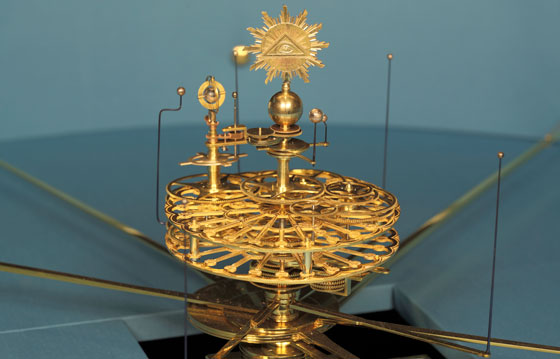
After a first traveling exhibition held in 2012, the Association Automates & Merveilles returns with a project aimed at preserving and highlighting the horological heritage of the Neuchâtel region. Three works by Pierre Jaquet-Droz, François Ducommun and Albert Billeter have been restored.
Automates & Merveiles is back! The association whose aim is to preserve and highlight the horological heritage of Neuchâtel has just inaugurated its second exhibition in seven years of existence. Titled Dreams from Three Eras, it presents three major horological artworks produced in the region: an Egyptian Revival Empire-style pendulum clock by Pierre Jaquet-Droz; a planetary clock by François Ducommun; and an astronomical clock ascribed to Albert Billeter. Loaned by the canton’s three major watchmaking collections – the Musée d’horlogerie du Locle – Château des Monts, the Musée international d’horlogerie de La Chaux-de-Fonds and the Musée d’art et d’histoire de Neuchâtel –, these works were first restored thanks to the support of generous donors. Traveling between the three associated institutions until October 28th, the exhibition picks up the the same itinerating concept as that used in 2012 for the previous exhibition highlighting three major figures of 18th century watchmaking: Pierre Jaquet-Droz, his son Henri-Louis and their associate Jean-Frédéric Leschot.
More than just an exhibition, Dreams from Three Eras is designed as a full-fledged endeavour to safeguard the horological heritage. The three objects were first studied in detail and structurally examined. The association then sought to enlist all the talents required to bring the project to fruition: the restorer-watchmakers teams of the museums, naturally, along with experts from the Haute Ecole-Arc, a dendrochronologist, a furniture and object conservator-restorer of paintings and wood sculptures, an art expert, historians, a conservator-restorer-watchmaker as well as museologists. Their work has given rise to a four-volume boxed set comprising three monographs and a DVD of a film documenting the restoration work undertaken.
Pierre Jaquet-Droz songbird pendulum clock
Acquired in 1984 for the 25th anniversary of the installation of the Musée d’Horlogerie du Locle in the Château des Monts, the Songbird clock by Pierre Jaquet-Droz (1721-1790) called for 730 hours of restoration involving eight artisans. This imposing and majestic work in the Egyptian Revival Empire style features a mahogany cabinet adorned with gilt bronze decorative elements from the Napoleonic empire. The double fusee-and-chain movements strikes the hours and quarters on two gongs, while the bird song is produced by a serinette with a pin barrel housed in the upper part of the clock. This instrument can play six different tunes on ten flutes. While the melody resounds, the bird spins while opening its beak, shaking its tail feathers and puffing out its throat. The mechanism driving the serinette is fitted below the clock movement and the two are connected via a small belt. The serinette can be activated manually, on request, by tugging on the small cord located on the left-hand side of the clock, or automatically triggered “in passing” on the hour. A small lever, placed on the right-hand side of the cabinet, serves to choose one of the six available tunes, while a second one below it can be used to activate or silence the serinette.
Planetary clock by François Ducommun
The second work selected, the Planetary clock (also known as an orrery) by François Ducommun (1763-1839), dating from 1817, has been safeguarded by the International Watchmaking Museum in La Chaux-de-Fonds since 1909. The mechanism comprises the planetary system as well as a perpetual calendar, both operated by a crank. The central movement represents the solar system as it was understood in the early 19th century: the Sun is surrounded by seven planets and their satellites. The periods of revolution, rotation and the apsides are also depicted. The mechanical part is protected by two hemispheres composed of glued sheets of paper adorned with zodiac signs and constellations. Restoration work on the paintings and their analysis confirmed their attribution to Charles-Samuel Girardet (1780-1863). The upper hemisphere can be raised to reveal the mechanism. Five people devoted around 672 hours to restoring this planetary clock that sits on a caster-mounted wooden base.
Astronomical clock by Albert Billeter
There is unfortunately very little documentation in the archives of the Musée d’art et d’histoire de Neuchâtel on the third creation: an imposing astronomical clock by Albert Billeter (1815-1895). This work nonetheless provided an opportunity to become acquainted with a horologist clearly driven by the quest for precision. Having joined the institution’s collections in 1931, this timekeeping mechanism comprises a pin pallet escapement, as well as a balance keeping time to the nearest second with mercury temperature compensation. The astronomical indications appear in subdials with enamel cartouches, themselves fixed to a central brass plate. The displays comprise mean time, legal time, the equation of time, a complete calendar (date, day, month and year), signs of the zodiac, central seconds and the lunar cycle. The winding system was modified at a later date to run on electricity, which is why the chiming mechanism and the perpetual calendar’s return system are missing. Two restorers spent 679 hours on this project.
Finally, this exhibition also provided an opportunity to conduct a comprehensive study aimed at reproducing the chains that Jaquet-Droz used for his fusee systems, indispensable in the transmission of driving force to the various mechanisms (for the clocks and for music). This project is a joint project shared by the three institutions, since each are owners of works by this eminent horologist. The development of the blanking swage as well as the creation of links and assembly were entrusted to students at the CIFOM-ET in Le Locle (Centre interrégional de formation des Montagnes neuchâteloises, technical division) under the supervision of Sylvain Varone, head of the watchmaking sector.
May 03, 2018


 News
News